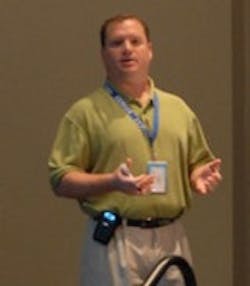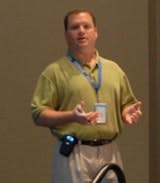Beauty Is as Beauty Does at Consumer Products Forum
The household and personal care industry is an important vertical market for Rockwell Automation, as Mike Jamieson, industry team director, pointed out in the HPC Industry Forum Wednesday morning at Automation Fair 2007. In describing the business drivers that control the vertical, customer satisfaction is key, Jamieson said. Operational efficiency, globalization, outsourcing of manufacturing, and regulatory compliance are the forces that impact on the industrys ability to provide that all-important customer satisfaction.
So many have turned to Rockwell Automation for solutions.
Our scope of offerings is really a value-add continuum, Jamieson said, from components and intelligent motor control through integrated architecture and information solutionsall the way to service and support.
He noted that one of the most important things Rockwell Automation provides is seamless simplicity. You want a system that makes it easy for an operator to introduce a new recipe, he said. We also offer pre-packaged vertical solutions so that we can deliver a pre-validated solution thatll start up first try. We have a whole library of those solutions.
Our challenges are cost containment, providing fast response and shortened delivery time, keeping up with new customer demands, future-proofing our designs and did I mention cost containment??? Kevin Zeinemann, along with Jeff Wold of diaper-making machinery manufacturer Curt G. Joa, on the issues facing machine builders supplying the personal care industry.
Canned Customization
Brad Stasny from New Brunswick Scientific made no bones about why this manufacturer of fermenters, bioreactors and other devices for the cosmetics and pharmaceuticals industry standardized on Rockwell Automation.
At the end of the day, we get simplified software using RSLogix 5000, decreased lead times for our customers, reduced service calls and service call time, Stasny said. We met our goal: not to radically change the look and feel of our control systems but to change what was behind the scenes.
NBS partnered with Rockwell Automation in 2006, using CompactLogix controllers, Panelview Plus operator interface terminals, Powerflex drives and assorted additional industrial grade components. Were compatible with ISAs S88 standard for recipe management and trending tools, conforming to GaMP guidelines, and we have a fully configurable system that we can off the shelf customize in many different waysand which provides the electronic record keeping that CFR21 Part 11 requires, Stasny concluded.
The Diaper Dilemma
Jeff Wold and Kevin Zeinemann, from Curt G. Joa, Inc., one of the worlds leading manufacturers of diaper-making machinery, told of the ongoing reinvention of their 75-year-old integrator/machine builder, located in Wisconsin. We call it Joa 2.0, Zeinemann cracked, after Web 2.0. We need to leverage our automation technology without overwhelming the customers.
Were in a very confidential business, Wold said, and were under a lot of pressure from our customers.
Zeinemann chimed in, Our challenges are cost containment, providing fast response and shortened delivery time, keeping up with new customer demands, future-proofing our designs and did I mention cost containment???
Previous to standardizing on Rockwell Automation, Joa had 8 vendors, 4 networks, lots of wires and one big headache! Zeinemann explained that they have now migrated to a system built around Logix, with Ethernet/IP for most communications and Sercos for the servo drives. Theyve even incorporated GuardLogix safety PLCs into their systems for compatibility. Theyve taken into account standardized releases, and they have even put together a library of widgets for the HMIs.
We see our machines in the future with full fieldbus communications, and probably lots of wireless connectivity, Zeinemann said.
Wold showed a video of some Joa machines in operationone making diapers, one making medical wound coverings. The products moved through the machine so fast that it was impossible to see them. You could only see a blur.
Okay, You Do It
Last on the dais but certainly not least, was Crisanne Mortensen, engineering manager for the Clinton, Conn., facility of Unilever Americas. One of the oldest Unilever facilities, the 125-year-old plant has aging pains, and when Mortensen took her present job, not a single controls engineer. Her boss told her, Figure it out! I dont want to get called on the weekends.
Clinton operates 24/6, producing 285 SKUs with more than 3,000 changeovers and 5,000 batch runs a year. She said she wanted to have a life too, so she determined that it would be impossible to hire a complete control systems engineering department, so she called Rockwell Automation and outsourced her entire automation engineering function to them.
The Clinton facility piloted a partnership with Rockwell Automation for 24/7 support, after suffering 66 hours per month downtime due solely to controls issues. Rockwell Automation studied the plants problems, staffed five engineers on call (and its always the same set of engineers, Mortensen said, not like calling a support line and taking pot luck). Rockwell Automation maintains a program library with check-out privileges, troubleshoots through a heavily cyber-protected DSL remote service line, and Mortensen and the Rockwell Automation rep have a monthly review process.
Theyve experienced a reduction of issues of 75% in the first 90 days, with increased cycle time of 20% on key ramps, by downtime reduction, Mortensen said. Rockwell Automation provides full solutions, with root cause analysis, not spot solutions. And they are upskilling my technicians every time theres a problem, too, she reported.
Unilever pays a flat fee monthly. Rockwell Automation even manages capital expenditure projects as full members of the engineering team. They write the CAPEX proposals, Mortensen approves them and gets Unilever management buy in, and then Rockwell Automation staffers execute the proposal, and manage the cash flow with reporting, just as if they were staff engineers.
This created a dynamic solution, where for a small amount of money, we have access to all of Rockwell Automation, Mortensen said.


